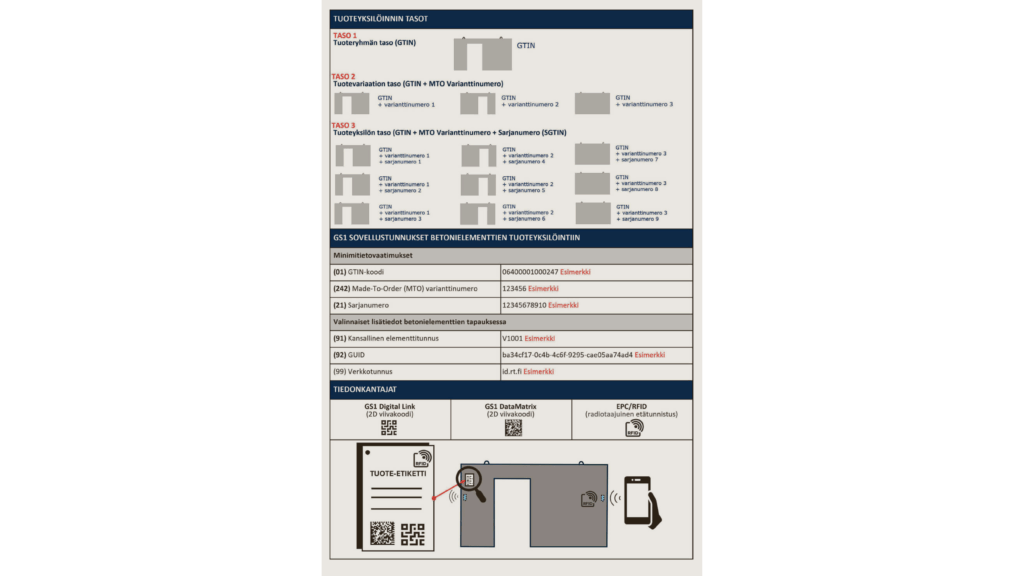The BETK working group has prepared a practical application guide for the construction and building products industry, which defines how concrete elements should be identified and identified to promote the digitalization of the production chain by utilizing GS1 standards. The BETK working group's project manager Teemu Alaluusua and the Concrete Industry Division Manager Janne Kihula open the guidelines in this article.

GS1 Global and industry-independent supply chain management standards developed by the International Organization for Standardization (IOS) such as the Global Trade Item Number (GTIN) for product identification together with the EAN barcode have become established in practice for inventory-driven construction products. For custom-designed construction products such as precast concrete elements, product identification and identification methods according to global standards have not yet become established, because unlike inventory-driven products, each individual item must be identified separately.
The application of global supply chain standards to product identification is a prerequisite for the digitalization of the production chain, regardless of the manufacturing logic of the products. In this context, the identification and identification standards according to the GS1 standard enable, among other things, the connection of physical products with their managed information in digital form, thus starting to materialize the so-called digital product and process twin thinking.
The minimum requirement of the BETK working group's application guidelines is based on the three-level product identification of the GS1 standard
In the solution presented in the application instructions The minimum data requirements for product identification of concrete elements should be based on a three-level product identification according to the GS1 standard, which takes into account the product group level, the product variation level and the product individual level. In addition to the minimum data requirements, there is also a need for optional additional data fields for the national element identifier, the GUID identifier defined by the modeling program and the domain name used for linking the information.
In order to provide minimum information requirements and optional additional information for the identification of concrete elements, the application guide recommends adding at least a 2D code based on optical identification to the element's product label during manufacture. In addition to the 2D code used on the element's product label, a machine-readable data carrier based on passive UHF RFID technology can also be used, either on the element's product label or cast into the concrete element.
To support the development of the application guidelines, the BETK working group tested standardized product identification and machine identification of concrete elements using GS2024 data carriers in the supply chain of two different residential apartment building projects in the autumn of 1. The data carrier solution tested the functionality of passive UHF RFID tags cast into the elements. This pilot and its findings will be discussed in more detail in a follow-up article to be published in the next issue of Betoni magazine.
Authors and additional information:
Teemu Alaluusua, Con X Digi Technologies Oy RT's Concrete Element Supply Chain Project Project Manager and Steering Group Member, teemu.alaluusua@condigi.com
Janne Kihula, M.Sc. (Eng.), Division Manager, Concrete Industry
Progress of the BETK project
Promoting the digital transformation of the industry, the BETK working group is currently meeting weekly to standardize the data content specifications of parts of the production chain and to promote the use of open data transfer solutions in the design, product, event, transportation and transaction data exchange processes between the construction and building product industries.
The precast concrete product development project (BETK) has progressed in stages. The work began in 2023 with a current status survey, which covered the ordering, design and installation phases. Based on the survey, a root cause analysis was prepared, which revealed bottlenecks in the flow of information and development needs.
This work resulted in an information architecture description of the target state. It outlines the process steps, actors, and current and developing information services, and is based on international standards. The description will be updated as the project progresses, and its purpose is to serve as a guideline towards a unified digital operating model.
You can follow the activities of the BETK working group on the Betoni.com website.